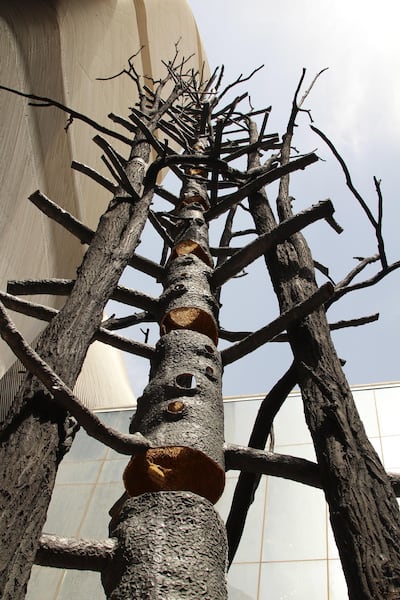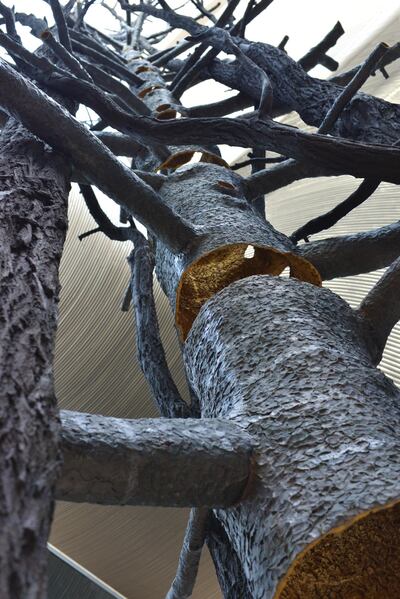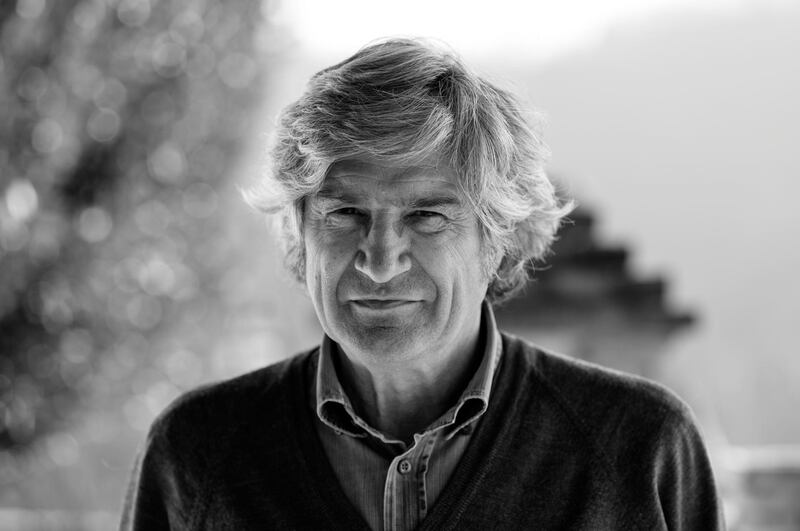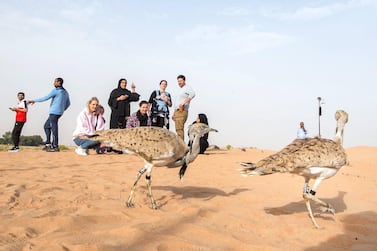It is not until the sky has faded to a soft grey that we are taken down a wide, spiralling walkway to see Source of Light, Giuseppe Penone's towering sculpture, installed last week at the King Abdulaziz Centre for World Culture (Ithra) in Dhahran. As we step on to an open-air, tapered square known as "the Source" – the exact spot where, in 1938, oil was discovered in the Kingdom – Penone's sculpture rises up before us about 27 metres into the sky. It immediately becomes clear why we have waited until dusk to see it.
Source of Light consists of three bronze trees, which surround a fourth, stainless-steel tree hovering a few feet above the ground. It is connected to the other trees by 64 branches. This central tree has been divided into 12 sections and hollowed out, the inside of the trunk covered in gold leaf and LED lights.
Seen from a distance, you get only the slightest hint of the warm light emanating from inside the central trunk, as if each section is a hearth whose door has been left ajar. But as you walk underneath the trunk, you look straight up through a shimmering golden tunnel, which seems to twist endlessly towards the clouds. There is also the option to flood "the Source" with water, meaning the light from the sculpture is reflected, or to turn on fountains embedded in the ground to give the impression that the sculpture is emerging from mist.
It is Penone's largest commission to date, but Source of Light nevertheless has a quietness to it – the bronze outer trees rooted to the floor offsetting the incandescent vitality of the central trunk they huddle around. "Gold is light, light is life," Penone tells The National at the official unveiling of Source of Light. "The attraction to gold is related to this idea of energy and life. A tree grows because of light and allows it to escape the forces of gravity."
A focus on Ithra
This idea of growth through illumination is at the heart of the Ithra project. Opened in June last year, Ithra is a vast cultural centre, featuring a cinema, library, theatre and three art galleries. It is a Saudi Aramco initiative – funded, then, by the profits from oil – but was built to diversify the economy and engage the local community in culture.

"It conveys a transformational point in time for the whole Kingdom," says Fatmah Al Rashid, head of Ithra advisory board. "Eighty years ago, this was the place where the wealth and prosperity of the Kingdom started. What we wanted to celebrate was a different kind of prosperity and that is one that comes from the energy of the people. Prosperity evolves and that's the story of our lives, it doesn't come only from one source."
Source of Light represents a beacon for this mission, and it has been many years in the making. In 2011, Ithra launched an international competition to find an artist who would create the sculpture for "the Source". When all the submissions had been received, a jury spent two days discussing the proposals. "Penone's was, without doubt, the best piece," says Kjetil Thorsen, one of the partners at Snohetta, the Norwegian architecture firm that designed Ithra. "I think people will feel extremely close to this work."
His greatest work
Penone, 72, selected a larch tree, chosen for its shape and number of branches, from which he moulded in metal the central trunk of Source of Light. At a foundry in Tuscany, Penone and his team made a silicon mould of each branch and section of trunk, coated these hollow tubes with wax and covered them in fireproof plaster and brick dust. These were then placed in an oven, where the wax melted, leaving space for the molten metal to be poured in.
The sculpture was assembled in Tuscany before being cut into sections and shipped to Dhahran. "It was a huge challenge," says Penone. "It's the greatest work I've ever done."

That's quite the endorsement from Penone, who had his first solo exhibition in 1968 at the age of 21 and was a major part of the Arte Povera movement. He championed the use of organic and ephemeral materials (in one of Penone's best-known works, he attached a cast of his arm to a sapling, which grew around the human limb, joining man and nature) and represented Italy at the Venice Biennale in 2007.
His hair might be a little greyer these days, although there is still an enviable amount of it, and his mannerisms a little more careful, but Penone's passion for his art remains as ardent as ever. He speaks with a lyricism that comes from a lifetime spent with nature. We ask him what it is about trees that continues to intrigue him after all these years (you can see another of his tree sculptures in Louvre Abu Dhabi). "The tree is a fluid material, it is not static," he says. "The history of the tree is inside the wood of the tree and this is fantastic in terms of a symbol of sculpture. If a man could create a sculpture that contains the necessity of life, it would be the best sculpture that can be done."
'A point for reflection'
Ithra is built – figuratively and literally – on oil and we can't help but wonder whether there is a contradiction between Penone's sculpture and its placement in Saudi Arabia. Oil is an organic material, but it is a fuel for man-made objects; it is the liquid that powers machines. Penone tackles this head-on in a promotional video for Ithra. "The desert is a place for oil extraction," he says. "There is an energy that comes out from the ground and you can feel this energy. This is a focal point for our civilisation and for our economy."
Penone's point seems to be that this tree flourishes at "the Source" in the same way Saudi Arabia has flourished because of what was discovered here. But when we push him on this point, Penone concedes that, "to have a tree inside a centre where they produce oil is cause for reflection. There is no contradiction. You think there is a misunderstanding but in reality, it is simply a point for reflection".
Reflection – yes, that's the word that best sums up Source of Light. It invites you to think about life, inter-connectivity and the beauty of the natural world. In short, this remarkable sculpture does exactly what a great artwork should do – it delights and challenges us. "It pushes a dialogue between people," says Penone. "I hope this will be the future of my piece."
Source of Light is on show now at the King Abdulaziz Centre for World Culture in Dhahran












